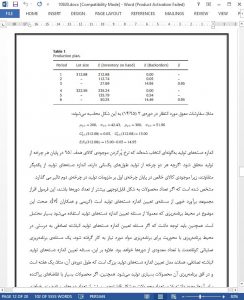Abstract
This paper deals with the dynamic multi-item capacitated lot-sizing problem under random period demands (SCLSP). Unfilled demands are backordered and a fill rate constraint is in effect. It is assumed that, according to the static-uncertainty strategy of Bookbinder and Tan [1], all decisions concerning the time and the production quantities are made in advance for the entire planning horizon regardless of the realization of the demands. The problem is approximated with the set partitioning model and a heuristic solution procedure that combines column generation and the recently developed ABCb heuristic is proposed.
1. Introduction
We consider the stochastic version of the dynamic multi-item capacitated lot-sizing problem (CLSP). The problem is to determine production quantities to satisfy demands for multiple products over a finite discrete time horizon such that the sum of setup and holding costs is minimized, whereby a capacity constraint of a resource must be taken into consideration. In contrast to the deterministic CLSP, we assume that for every product k and period t the demand is a random variable Dkt (k¼1,2,y,K; t¼1,2,y,T). The period demands are non-stationary (to permit dynamic effects such as seasonal variations, promotions, or general mixtures of known customer orders with random portions of period demands), which usually is the case in a material requirements planning (MRP) based environment. Demand that cannot be filled immediately from stock on hand is backordered. As the precise quantification of shortage penalty costs which involve intangible factors such as loss of customer goodwill is very difficult, if not impossible, we assume that management has specified a target service level. In particular, we assume that the fill rate criterion (b service level) is in effect, as this criterion is very popular in industrial practice (see Tempelmeier [2]).
6. Conclusion
In this paper we introduced an approximate model for the single level capacitated lot-sizing problem with dynamic stochastic demand under a fill rate constraint. We proposed to combine a column generation procedure to solve the LP-relaxation of the model with the ABCb heuristic of Tempelmeier and Herpers [6] to solve the remaining problem. The quality of the solutions is compared to the results found with the application of the ABCb heuristic of Tempelmeier and Herpers [6] alone. It was found that the proposed heuristic is fast and that it provides solutions that are on the average superior to the ABCb heuristic.











